Brightspace
Quizzes — Creating a Quiz

On this page:
Getting Started
To see a quick overview of quiz creation, please watch the short video below.
Note: We highly recommend using the Question Library to create and organize questions before importing them into a quiz. Please see Using the Question Library Quick Start Guide.
Accessing the Quiz Tool
Go to Course Materials > Content > Upload/Create > New Quiz
 We recommend creating quizzes directly in Content. Why? When you create a quiz via the Manage Quizzes page, students will only be able to access the quiz through the Tools menu in your course navbar. The quiz will not be visible in the content area of your course page unless you add it to a module/submodule using the existing activities menu.
We recommend creating quizzes directly in Content. Why? When you create a quiz via the Manage Quizzes page, students will only be able to access the quiz through the Tools menu in your course navbar. The quiz will not be visible in the content area of your course page unless you add it to a module/submodule using the existing activities menu.
Step 1: Enter Quiz Details
When creating a new quiz, you will start by adding quiz details.
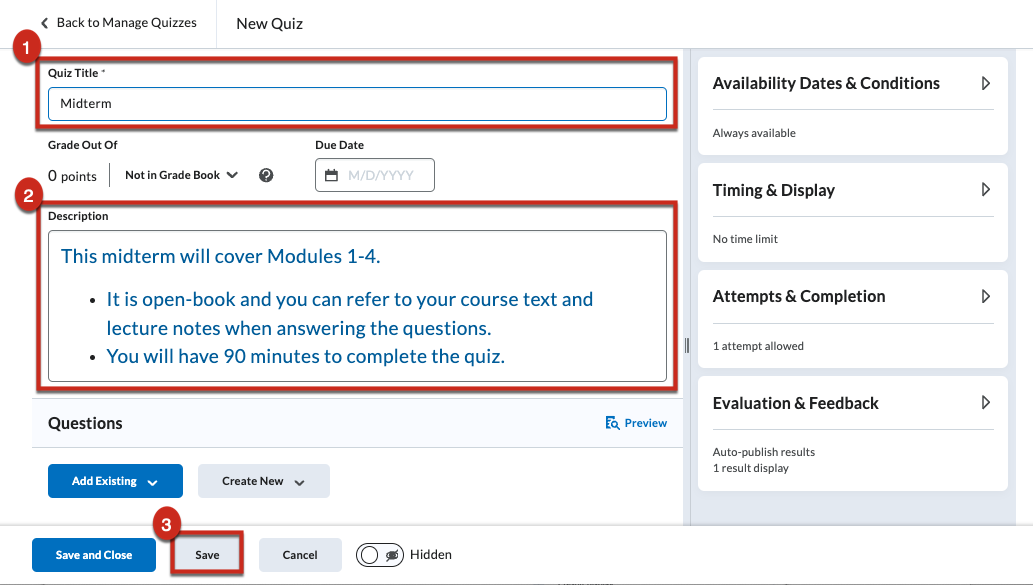
- Title: this is a mandatory field (hint: give all your quizzes descriptive titles that will clearly identify them for both you and your students)
- Description: students will see the description on the Start Quiz page so this is where to include any instructions you want students to see immediately before they begin the quiz (hint: making the instructions a larger font and a different colour, will help instructions to stand out on the screen)
- Save: as you build your quiz and adjust the settings, don’t forget to Save regularly
Step 2: Link to Grade Book
All quizzes that contribute toward the final grade should have an associated item in the grade book. If the grade book has already been set up, connecting the quiz to the grade book is straightforward.
To connect a quiz to the grade book, go to the Grade Out Of settings, click on the drop-down for the Grade Book association, and select Edit or Link to Existing.
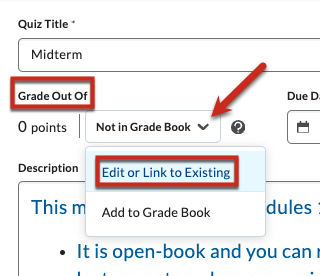
On the pop-up screen, click the radio button Link to an existing grade item and select the grade item for this quiz from the dropdown. Then click OK.
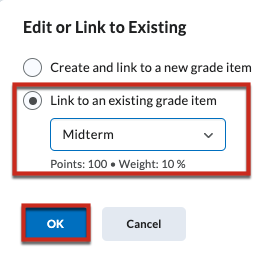
Step 3: Add Questions
To add questions to the quiz, click on:
- Add Existing dropdown (below the Description field)
- Browse Question Library

From the question library, you will have the following options:
- Select entire sections (this will import any description, including text or media, that has been added to the section, as well as any questions contained within that section); or
- Select individual questions (sections can be expanded by clicking the arrow to the left of the checkbox; this will allow you to select individual questions within a section).
Once the selections are made, click Import.
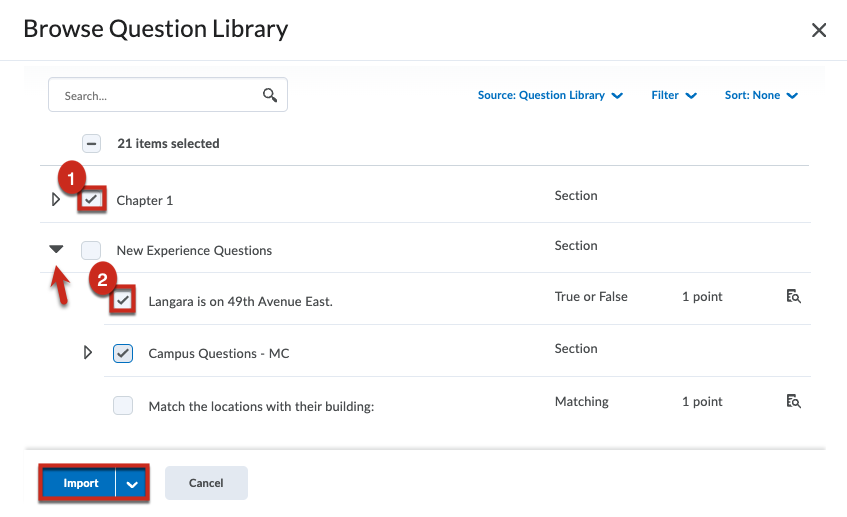
Step 4: Verify Total Points Value
Quiz is in Grade Book
Once all questions have been added, adjust the points total in the Grade Out Of box.
If the quiz has been linked to the grade book, the total number of points will be automatically taken from the ‘weighting’ of the grade item towards the final grade (e.g. if the quiz is worth 10% of the final grade, this score will default to 10 points).

However, once all of the questions have been added, the total points should be manually adjusted to align with the total points value of the questions in the quiz.
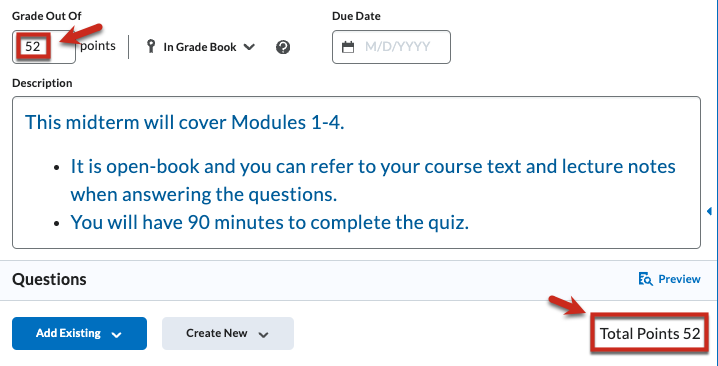
Quiz is Not in Grade Book
If the quiz is not connected to the grade book, the points will be automatically taken directly from the total value of the questions added to the quiz and will not be editable.

Step 5: Specify Dates
See also Dates, Deadlines, and Availability Quick Guide.
You have two options for adding deadlines: 1) Due Date; and 2) Availability Dates

Use a Due Date if the quiz is lower stakes and you would like it completed by a certain time, but don’t want to stop a student from taking it past the deadline (quizzes submitted past the deadline will be accepted but marked as late).

Use Availability Dates if the quiz is higher stakes and you only want it accessible for a specified period. For example, you can specify that the quiz must be started between 3:00 pm and 3:20 pm on October 21. At the end of the availability window (i.e. Oct 21 at 3:20pm), the student will no longer be able to begin the quiz.
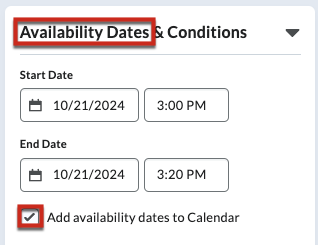
Due Dates vs Availability Dates
- Although you can add both a due date and an end date, we recommend using one or the other to avoid confusing students. End dates will override due dates.
- Due dates will automatically be added to the course calendar. If using Availability Dates, click the box below the dates to ensure that availability dates are added to the calendar (this is not automatic).
- Availability windows may or may not affect the length of time the student has to complete the quiz once they’ve started. See Time Limits below to learn more about synchronous and asynchronous time limits.
Step 6: Set a Time Limit
Higher stakes quizzes generally have a time limit. This is set in the Timing & Display tab.
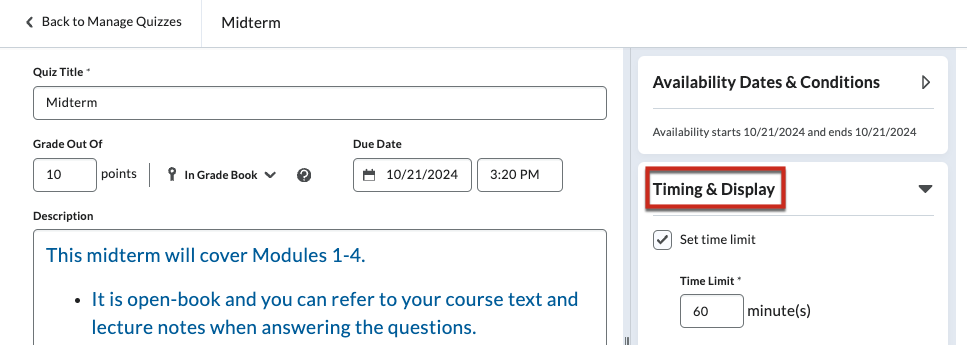
The default is for quizzes to be auto-submitted for grading once the time limit has been reached.
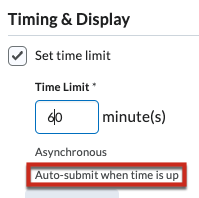
Synchronous Versus Asynchronous Time Limits
Whether an instructor wants to use a synchronous or asynchronous time limit depends on whether the quiz is designed to have a synchronous start for all students or not. The default setting is asynchronous, but this can be changed by clicking the Timer Settings button.
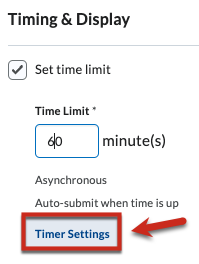
Use a synchronous time limit when you want the quiz timer to begin on the start date/time and stop at the time limit for all learners. Learners who start late (but within the availability window), will be able to take the quiz but they will have less time to complete it (e.g. if they begin a 60 minute quiz 10 minutes after the start time, they will only have 50 minutes to complete it).
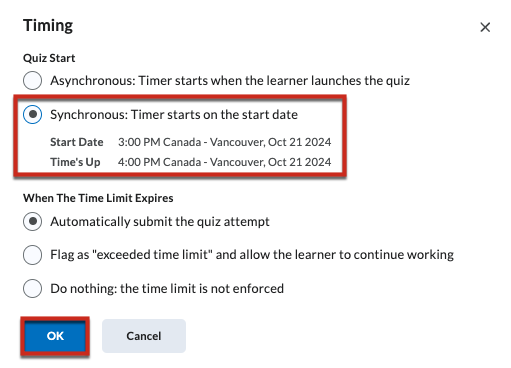
For students taking a synchronous quiz, the Start Quiz button is disabled until the start time. A countdown timer will be visible on the Start Quiz page to indicate the remaining time before the quiz becomes available.

If an instructor wants the students to be able to begin the quiz at any time within the availability window and have the full time limit to complete it, use the asynchronous option (this is the default). This quiz setting is commonly used in fully asynchronous courses with students who might have varied schedules, as well as for lower stakes quizzes.
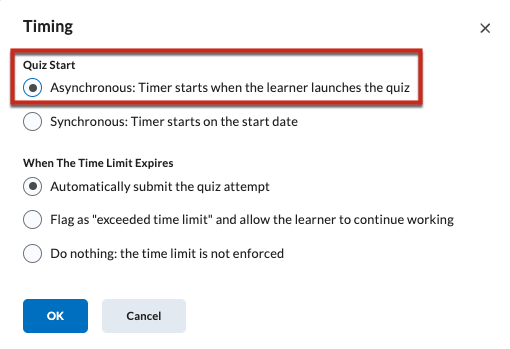
Students who start an asynchronous quiz any time within the availability window — even 1 minute before the end date — will have the full time limit to complete the quiz.
Recap: Availability Window vs Time Limit
Availability window (Start/End Dates): the time period during which a student can begin a quiz
Time Limit: the amount of time the student has to complete a quiz once they’ve started it
Step 7: Specify Paging
Specify how many questions the students will see on each page of the quiz using the Paging drop-down in the Timing & Display tab.

Decide on the number of questions to display per page and whether or not you will allow them to navigate backwards to previous pages.
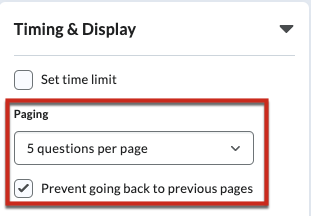
 When deciding on the number of questions to display per page, consider a balance between exam integrity and exam anxiety. Allowing students to see all exam questions at once will increase opportunities for academic misconduct, but allowing students to see only one question per page often increases exam anxiety (and increased anxiety is a risk factor for students to commit academic misconduct).
When deciding on the number of questions to display per page, consider a balance between exam integrity and exam anxiety. Allowing students to see all exam questions at once will increase opportunities for academic misconduct, but allowing students to see only one question per page often increases exam anxiety (and increased anxiety is a risk factor for students to commit academic misconduct).
Consider a balanced approach:
- allow students to see several (but not all) questions on each page as this can reduce anxiety by allowing them some choice in which questions to answer first
- click the box Prevent going back to previous pages to prevent students from having unlimited opportunities to revisit previous answers
Step 8: Set Category
Choose a category to organize Quizzes by type, topic, or other grouping.
Step 9: Specify Evaluation & Feedback Settings
The default settings under Evaluation & Feedback are set to automatically publish the Attempt grade (score) when the quiz is submitted. It is important to consider whether or not the quiz can be reliably auto-graded when it comes to these settings.
Consider Whether to Auto-Publish Results
If the quiz consists solely of questions that can be reliably auto-graded (e.g. multiple choice, True/False, etc.), there are no issues with result accuracy if you publish the students’ scores upon submission (the default setting).
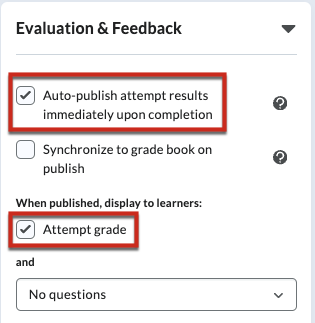
However, auto-publish is not recommended if there are any questions in the quiz which require students to type answers as these will require review (e.g. short answer, fill-in-the blank, etc.) or manual grading (written response). Unclick the box Auto-publish attempt results immediately upon completion if there are any quiz questions requiring typed answers.
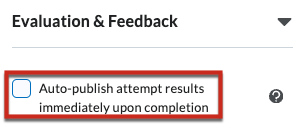
Synchronize to Grade Book
If you linked the quiz to your grade book, make sure you select the option to Synchronize to grade book on publish or you will need to manually push the scores to the grade book.
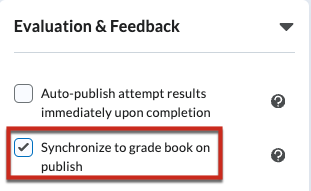
Show Feedback and/or Questions
Students will only see their published score under the default settings. If you want them to see how they did on specific questions, any feedback you added while grading, and/or the correct answers, you will need to change the display settings. For help with this, please reach out to EdTech.
Step 10: Save & Preview
As a final step, make sure that you:
- Save your quiz
- Preview your quiz (the Quiz preview replicates the student experience exactly)
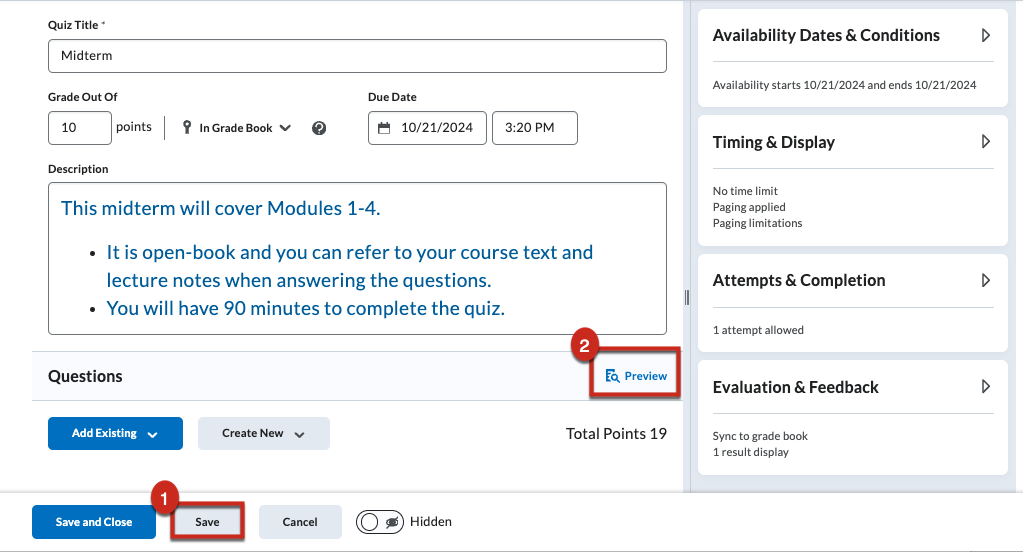

Contact edtech@langara.ca for more information.


